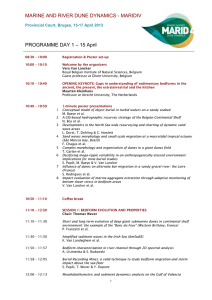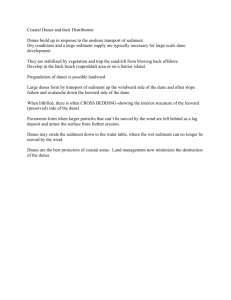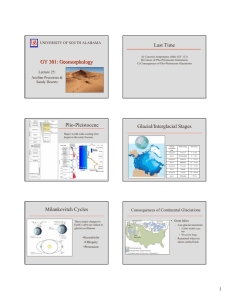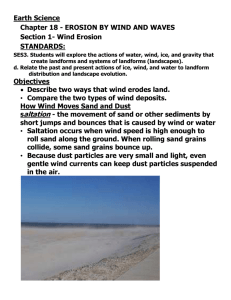An experimental investigation of 3D subaqueous barchan dunes G. Blois
advertisement
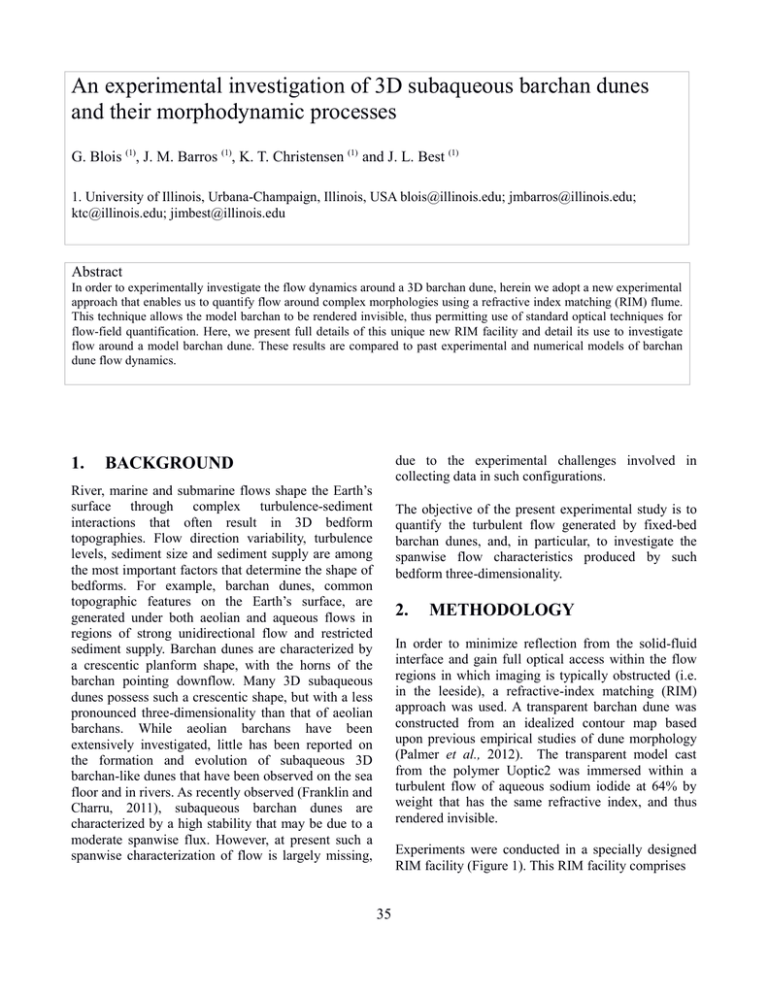
An experimental investigation of 3D subaqueous barchan dunes and their morphodynamic processes G. Blois (1), J. M. Barros (1), K. T. Christensen (1) and J. L. Best (1) 1. University of Illinois, Urbana-Champaign, Illinois, USA blois@illinois.edu; jmbarros@illinois.edu; ktc@illinois.edu; jimbest@illinois.edu Abstract In order to experimentally investigate the flow dynamics around a 3D barchan dune, herein we adopt a new experimental approach that enables us to quantify flow around complex morphologies using a refractive index matching (RIM) flume. This technique allows the model barchan to be rendered invisible, thus permitting use of standard optical techniques for flow-field quantification. Here, we present full details of this unique new RIM facility and detail its use to investigate flow around a model barchan dune. These results are compared to past experimental and numerical models of barchan dune flow dynamics. 1. due to the experimental challenges involved in collecting data in such configurations. BACKGROUND River, marine and submarine flows shape the Earth’s surface through complex turbulence-sediment interactions that often result in 3D bedform topographies. Flow direction variability, turbulence levels, sediment size and sediment supply are among the most important factors that determine the shape of bedforms. For example, barchan dunes, common topographic features on the Earth’s surface, are generated under both aeolian and aqueous flows in regions of strong unidirectional flow and restricted sediment supply. Barchan dunes are characterized by a crescentic planform shape, with the horns of the barchan pointing downflow. Many 3D subaqueous dunes possess such a crescentic shape, but with a less pronounced three-dimensionality than that of aeolian barchans. While aeolian barchans have been extensively investigated, little has been reported on the formation and evolution of subaqueous 3D barchan-like dunes that have been observed on the sea floor and in rivers. As recently observed (Franklin and Charru, 2011), subaqueous barchan dunes are characterized by a high stability that may be due to a moderate spanwise flux. However, at present such a spanwise characterization of flow is largely missing, The objective of the present experimental study is to quantify the turbulent flow generated by fixed-bed barchan dunes, and, in particular, to investigate the spanwise flow characteristics produced by such bedform three-dimensionality. 2. METHODOLOGY In order to minimize reflection from the solid-fluid interface and gain full optical access within the flow regions in which imaging is typically obstructed (i.e. in the leeside), a refractive-index matching (RIM) approach was used. A transparent barchan dune was constructed from an idealized contour map based upon previous empirical studies of dune morphology (Palmer et al., 2012). The transparent model cast from the polymer Uoptic2 was immersed within a turbulent flow of aqueous sodium iodide at 64% by weight that has the same refractive index, and thus rendered invisible. Experiments were conducted in a specially designed RIM facility (Figure 1). This RIM facility comprises 35 temperature constant to within 0.1 oC, translates to a 0.001% change in the fluid RI. two main components: 1) a recirculating, fully temperature-controlled, fluid channel and 2) a dedicated storage/processing vessel, designed to provide mixing, deoxygenation and safe storage of the working fluid. Both of these components were designed to handle corrosive working fluids under a broad range of pressure conditions. The tunnel test section, entirely constructed with clear acrylic (19.10 mm thickness), is 2.50 m long with a constant cross-section of 0.1125 × 0.1125 m2. The slope of the test section is adjustable from 0 to +2% and the slope can be monitored using a liquid capacitive, gravity-based inclinometer. Flow conditioning was provided by a contraction section (area ratio = 4.375:1) and a series of perforated plates and screens. The flow quality downstream of this flow-conditioning arrangement was ascertained via 2D PIV measurements 0.6 m downstream of the test-section entrance. Finally, the contraction section cover was equipped with a cupola that assisted in trapping bubbles generated and advected by the flow. The pump system was designed to generate high flow discharges, handle corrosive liquids (e.g. NaI, ZnI2 solutions) and recirculate sediment up to 2 mm in diameter. The flume was equipped with two identical, close–coupled, fiberglass-reinforced centrifugal pumps that deliver a combined discharge in the range 1–0.016 m3s-1 when utilizing an aqueous solution of NaI as the working fluid and operating at 0% slope. The volumetric flow rate through the tunnel is monitored by an electromagnetic flow meter mounted in the return line of the system piping. To maintain a constant RI of the working fluid, the temperature of the system must be carefully maintained. The temperature control system was designed by coupling an in-line heat exchanger and an electronically-controlled modulating valve. A tube and shell heat exchanger was installed in the supply pipe. The working fluid is conveyed through a set of 36 titanium tubes (0.019 m diameter) held inside a PVC shell while the cooling fluid (at 15 oC) is circulated through the shell. The modulating valve regulates the flow rate of the cooling fluid, while a set-point controller monitors the temperature of the working fluid through input from a thermocouple probe installed in the upstream duct. If the temperature is higher than the set-point value, the modulating valve is opened by a 4-20 mA positioner and integral actuator. The temperature control process is fully automated and is able to maintain the which Figure 1. Photo of the model RIM flow facility showing the PIV system setup. The entire facility was designed to be airtight, handle low values of negative pressure and operate with low values of positive pressure. The pressure is regulated through a manifold installed in the cupola (see Fig. 1). The manifold is connected to: 1) a vacuum pump for ambient air removal; 2) a nitrogen tank that is used to maintain an inert gas-saturated environment within the tunnel; and 3) a manual relief valve for pressure regulation. Additionally, the cupola is equipped with a safety pressure relief valve that ensures the system cannot be dangerously over-pressurized (pressure safety value was 5 psi). This capability allows us to generate free-surface flows by filling the test section only partially with the working fluid and introducing nitrogen gas (N2) into the overlying space under a slight positive pressure. The use of N2 avoids the risk of discoloration of the salt solution (that occurs by I3ions formed by simultaneous exposure to oxygen and visible light) during operation of the facility. The ability to produce free-surface flow and adjust the slope allowed us to perform a wide range of Froudenumber-dependent flow experiments and ensures attainment of equilibrium, equal-depth, flows within the flume for open-channel applications. We used this capability to investigate both subcritical and supercritical flow conditions, with the flow depth being controlled by an adjustable overshot weir at the downstream end of the test section. A dedicated processing vessel allowed mixing of the solution while also preserving it from discoloration. To achieve this goal, a deoxygenation procedure was required. The processing vessel is connected to the vacuum pump through a fluid trap and to a highpressure nitrogen tank. The pressure is monitored 36 through a compound pressure gauge. The tank is connected to the tunnel via a piping system and the solution is transferred using a magnetically driven pump. The RI of the working fluid was varied in two ways: 1) gross variations achieved by altering the salt concentration of the solution; and 2) fine tuning by carefully adjusting the temperature of the working fluid. Measurements of flow around the clear complex topography models were carried out using a 2D PIV system. A 4 MP frame-straddle CCD camera (2048 2048 pixels) coupled with a 105 mm focallength lens was used to image the flow, while a dualcavity Nd:YAG laser (15 Hz and 120 mJ per pulse) provided coherent (λ = 532 nm) illumination. Optics were used to form a light sheet (in the streamwise– wall-normal plane) that was wide enough to illuminate the entire flow around the rectangular prism and to obtain a constant lightsheet thickness (~ 1.5 mm). The light was conveyed from the bottom of the channel using a system of optics mounted on a transition stage, which facilitated positioning of the light sheet at different spanwise locations. Measurements were performed with different magnifications in order to image the entire flow around the topography, as well as resolve the flow within the trough of the topography. Silver-coated hollow glass spheres (mean diameter, φ = 14 µm) with a density of 1.7 g cm-3 were added to the flow to serve as PIV tracer particles (the specific gravity of the RImatched fluid is ~1.8). Topographic models were constructed by casting a special clear polymer (Uoptic2) which has the same RI as the NaI solution. Negative molds based upon the digital model were built by rapid prototyping. Figure 2A shows the negative obtained using the digital model previously utilized by Palmer et al. (2012). The final bedform model was then cast using a proper mix of the polymer in its liquid form with a catalyst into these negatives. The resulting transparent bedform (Fig. 2B) was then introduced to the flow test section and rigidly mounted to the floor to ensure it remained static in the presence of the high Re flows under study. Figure 2. Photos of: A) barchan model mold; B) transparent barchan model used in experiments. The model consisted of a 5 mm thick square tile (11.25 mm side) on top of which the topography was built. The larger dune fabricated was 0.08 m long and 0.07 m wide. The tile was mounted on the wall of the test section. The distance between the inlet section of the channel and the model leading edge was 0.61 m. PIV measurements of the turbulent flow field were made in the streamwise–wall-normal plane along the centerline of the topography and in the streamwisespanwise planes at three different elevations. Two different barchan configurations were investigated: i) isolated, and ii) two co-axially aligned identical dunes. Four different volumetric flow rates were considered (Q = 3.1, 4.0, 4.9, 7.210-3 m3s-1) and the mean velocity of the incoming flow, U0, was estimated as Uo = Q/ (hw ∙ B) where hw is the flow depth and B is the width of the test section. These conditions yielded Re (Re = Uohw/ν, where ν is the kinematic viscosity of the working fluid) in the range 2.5 – 6.5 (104). 37 3. Figure 3. Photos of transparent barchan model immersed in A) water and B) aqueous solution of NaI. RESULTS The efficacy of our RIM technique was assessed through immersion of a barchan model within the NaI solution. Figure 3A shows the effect of immersion of the transparent barchan bedform in water; the distortion of the image is due to the RI mismatch between the liquid and the solid phase. In Figure 3B, the same barchan model is immersed in the NaI solution. The image shows how an accurate index match renders the solid phase optically invisible. This paper will present the first results of using this innovative new RIM method to examine flow around a 3D barchan dune, as well as modifications to the flow field produced by the presence of an upstream barchan dune. 4. REFERENCES Blois, G., Christensen, K.T., Best, J.L., Elliott, G., Austin, J., Garcia, M., Bragg, M., Dutton, C. and Fouke, B. 2012 A Versatile Refractive-Index-Matched Flow Facility for Studies of Complex Flow Systems Across Scientific Disciplines, 50th American Institute of Aeronautics and Astronautics (AIAA) Aerospace Sciences Meeting, Nashville, TN, AIAA Paper 2012-0736 (INVITED), January 2012. Bons, J.P., Taylor, R.P., McClain, S.T. and Rivir, R.B. 2001 The many faces of turbine surface roughness, J. Turbomach. 123, 739. Franklin, E.M. and Charru, F. 2011 Subaqueous barchan dunes in turbulent shear flow. Part 1. Dune motion, Journal Fluid Mechanics, 675, 199-222, DOI: http://dx.doi.org/10.1017/S0022112011000139. Palmer, J.A., Mejia-Alvarez, R., Rivera, E.M., Best, J.L. and Christensen, K.T. 2012 Particle-image velocimetry measurements of flow over isolated and interacting barchan dunes, Experiments in Fluids, 52, 809-829. 38
